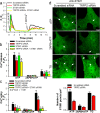TRPP2 and STIM1 form a microdomain to regulate store-operated Ca2+ entry and blood vessel tone
- PMID: 32867798
- PMCID: PMC7457527
- DOI: 10.1186/s12964-020-00560-7
TRPP2 and STIM1 form a microdomain to regulate store-operated Ca2+ entry and blood vessel tone
Abstract
Background: Polycystin-2 (TRPP2) is a Ca2+ permeable nonselective cationic channel essential for maintaining physiological function in live cells. Stromal interaction molecule 1 (STIM1) is an important Ca2+ sensor in store-operated Ca2+ entry (SOCE). Both TRPP2 and STIM1 are expressed in endoplasmic reticular membrane and participate in Ca2+ signaling, suggesting a physical interaction and functional synergism.
Methods: We performed co-localization, co-immunoprecipitation, and fluorescence resonance energy transfer assay to identify the interactions of TRPP2 and STIM1 in transfected HEK293 cells and native vascular smooth muscle cells (VSMCs). The function of the TRPP2-STIM1 complex in thapsigargin (TG) or adenosine triphosphate (ATP)-induced SOCE was explored using specific small interfering RNA (siRNA). Further, we created TRPP2 conditional knockout (CKO) mouse to investigate the functional role of TRPP2 in agonist-induced vessel contraction.
Results: TRPP2 and STIM1 form a complex in transfected HEK293 cells and native VSMCs. Genetic manipulations with TRPP2 siRNA, dominant negative TRPP2 or STIM1 siRNA significantly suppressed ATP and TG-induced intracellular Ca2+ release and SOCE in HEK293 cells. Inositol triphosphate receptor inhibitor 2-aminoethyl diphenylborinate (2APB) abolished ATP-induced Ca2+ release and SOCE in HEK293 cells. In addition, TRPP2 and STIM1 knockdown significantly inhibited ATP- and TG-induced STIM1 puncta formation and SOCE in VSMCs. Importantly, knockdown of TRPP2 and STIM1 or conditional knockout TRPP2 markedly suppressed agonist-induced mouse aorta contraction.
Conclusions: Our data indicate that TRPP2 and STIM1 are physically associated and form a functional complex to regulate agonist-induced intracellular Ca2+ mobilization, SOCE and blood vessel tone. Video abstract.
Keywords: Blood vessel tone; Polycystin-2; Store-operated Ca2+ entry; Stromal interaction molecule 1; Vascular smooth muscle cells.
Conflict of interest statement
The authors declare that they have no competing interests.
Figures








Similar articles
-
Phosphate-induced ORAI1 expression and store-operated Ca2+ entry in aortic smooth muscle cells.J Mol Med (Berl). 2019 Oct;97(10):1465-1475. doi: 10.1007/s00109-019-01824-7. Epub 2019 Aug 5. J Mol Med (Berl). 2019. PMID: 31385016
-
TRPP2 associates with STIM1 to regulate cerebral vasoconstriction and enhance high salt intake-induced hypertensive cerebrovascular spasm.Hypertens Res. 2019 Dec;42(12):1894-1904. doi: 10.1038/s41440-019-0324-5. Epub 2019 Sep 20. Hypertens Res. 2019. PMID: 31541223
-
Conformation of ryanodine receptor-2 gates store-operated calcium entry in rat pulmonary arterial myocytes.Cardiovasc Res. 2016 Jul 1;111(1):94-104. doi: 10.1093/cvr/cvw067. Epub 2016 Mar 24. Cardiovasc Res. 2016. PMID: 27013634 Free PMC article.
-
Molecular physiology and pathophysiology of stromal interaction molecules.Exp Biol Med (Maywood). 2018 Mar;243(5):451-472. doi: 10.1177/1535370218754524. Epub 2018 Jan 24. Exp Biol Med (Maywood). 2018. PMID: 29363328 Free PMC article. Review.
-
SOCE and STIM1 signaling in the heart: Timing and location matter.Cell Calcium. 2019 Jan;77:20-28. doi: 10.1016/j.ceca.2018.11.008. Epub 2018 Nov 27. Cell Calcium. 2019. PMID: 30508734 Free PMC article. Review.
Cited by
-
Mechanosensitivity in Pulmonary Circulation: Pathophysiological Relevance of Stretch-Activated Channels in Pulmonary Hypertension.Biomolecules. 2021 Sep 21;11(9):1389. doi: 10.3390/biom11091389. Biomolecules. 2021. PMID: 34572602 Free PMC article. Review.
-
X-Ray Causes mRNA Transcripts Change to Enhance Orai2-Mediated Ca2+ Influx in Rat Brain Microvascular Endothelial Cells.Front Mol Biosci. 2021 Sep 14;8:646730. doi: 10.3389/fmolb.2021.646730. eCollection 2021. Front Mol Biosci. 2021. PMID: 34595206 Free PMC article.
-
Vascular polycystin proteins in health and disease.Microcirculation. 2024 May;31(4):e12834. doi: 10.1111/micc.12834. Epub 2023 Oct 12. Microcirculation. 2024. PMID: 37823335 Free PMC article. Review.
-
Role of thrombospondin-1 in high-salt-induced mesenteric artery endothelial impairment in rats.Acta Pharmacol Sin. 2024 Mar;45(3):545-557. doi: 10.1038/s41401-023-01181-9. Epub 2023 Nov 6. Acta Pharmacol Sin. 2024. PMID: 37932403 Free PMC article.
-
Role of transient receptor potential channels in the regulation of vascular tone.Drug Discov Today. 2024 Jul;29(7):104051. doi: 10.1016/j.drudis.2024.104051. Epub 2024 Jun 3. Drug Discov Today. 2024. PMID: 38838960 Free PMC article. Review.
References
-
- Hofherr A, Kottgen M. TRPP channels and polycystins. Adv Exp Med Biol. 2011;704:287–313. - PubMed
-
- Grantham JJ, Mulamalla S, Swenson-Fields KI. Why kidneys fail in autosomal dominant polycystic kidney disease. Nat Rev Nephrol. 2011;7:556–566. - PubMed
-
- Chen XZ, Li Q, Wu Y, Liang G, Lara CJ, Cantiello HF. Submembraneous microtubule cytoskeleton: interaction of TRPP2 with the cell cytoskeleton. FEBS J. 2008;275:4675–4683. - PubMed
Publication types
MeSH terms
Substances
LinkOut - more resources
Full Text Sources
Miscellaneous

